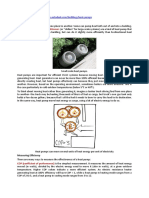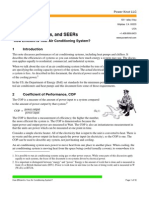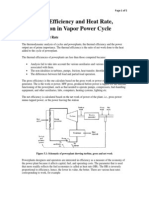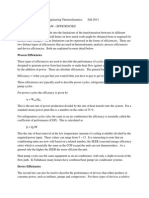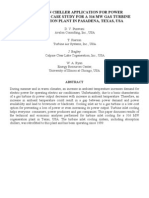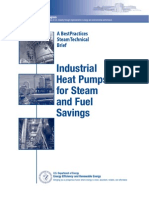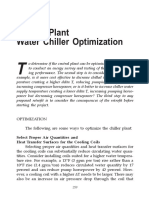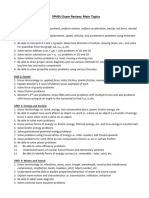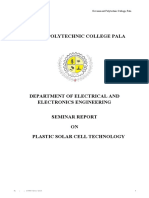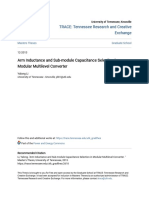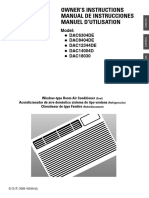Coefficient of Performance: From Wikipedia, The Free Encyclopedia
Coefficient of Performance: From Wikipedia, The Free Encyclopedia
Uploaded by
imtaftigosdCopyright:
Available Formats
Coefficient of Performance: From Wikipedia, The Free Encyclopedia
Coefficient of Performance: From Wikipedia, The Free Encyclopedia
Uploaded by
imtaftigosdOriginal Title
Copyright
Available Formats
Share this document
Did you find this document useful?
Is this content inappropriate?
Copyright:
Available Formats
Coefficient of Performance: From Wikipedia, The Free Encyclopedia
Coefficient of Performance: From Wikipedia, The Free Encyclopedia
Uploaded by
imtaftigosdCopyright:
Available Formats
Coefficient of performance - Wikipedia, the free encyclopedia
Page 1 of 4
Coefficient of performance
From Wikipedia, the free encyclopedia
The coefficient of performance or COP (sometimes CP), of a heat pump is the ratio of the change in heat at the "output" (the heat reservoir of interest) to the supplied work.
Contents
1 Equation 2 Derivation 3 Improving COP 4 Example 5 Conditions of use 6 See also 7 References 8 External links
Equation
The equation is:
where is the heat supplied to the hot reservoir is the work consumed by the heat pump.
The COP for heating and cooling are thus different, because the heat reservoir of interest is different. When one is interested in how well a machine cools, the COP is the ratio of the heat removed from the cold reservoir to input work. However, for heating, the COP is the ratio of the heat removed from the cold reservoir plus the heat added to the hot reservoir by the input work to input work:
where is the heat removed from the cold reservoir.
http://en.wikipedia.org/wiki/Coefficient_of_performance
9/1/2011
Coefficient of performance - Wikipedia, the free encyclopedia
Page 2 of 4
Derivation
According to the first law of thermodynamics, in a reversible system we can show that Qhot = Qcold + W and W = Qhot Qcold, where Qhot is the heat given off by the hot heat reservoir and Qcold is the heat taken in by the cold heat reservoir. Therefore, by substituting for W,
For a heat pump operating at maximum theoretical efficiency (i.e. Carnot efficiency), it can be shown that and , where Thot and Tcold are the absolute temperatures of
the hot and cold heat reservoirs respectively. At maximum theoretical efficiency,
Which is equal to the inverse of the ideal Carnot cycle efficiency because a heat pump is a heat engine operating in reverse. Similarly,
It can also be shown that COPcooling = COPheating 1. Note that these equations must use the absolute temperature (the Kelvin or Rankine scale.)
COPheating applies to heat pumps and COPcooling applies to air conditioners or refrigerators. For heat
engines, see Efficiency. Values for actual systems will always be less than these theoretical maximums. In Europe, ground source heat pump units are standard tested at Thot is 35 C (95 F) and Tcold is 0 C (32 F). According to the above formula, the maximum achievable COP would be 7.8. Test results of the best systems are around 4.5. When measuring installed units over a whole season and one also counts the energy needed to pump water through the piping systems, then seasonal COP's are around 3.5 or less. This indicates room for improvement.
Improving COP
As the formula shows, to improve the COP of a heat pump system, one needs to reduce the temperature gap Thot minus Tcold at which the system works. For a heating system this would mean two things. One is to reduce output temperature to around 30 C (86 F) which requires piped floor- or wall- or ceiling heating, or oversized water to air heaters. The other is to increase input temperature (by using an oversized ground source). For an air cooler, COP could be improved by using ground water as an input instead of air, and by reducing temperature drop on output side through increasing air flow. For both systems, also increasing the size of pipes and air canals would help to reduce noise and the energy consumption of pumps (and ventilators).
http://en.wikipedia.org/wiki/Coefficient_of_performance
9/1/2011
Coefficient of performance - Wikipedia, the free encyclopedia
Page 3 of 4
Also the heat pump itself can be improved a lot. The two most simple ways to improve heat pump units, is to double the size of the internal heat exchangers relative to the power of the compressor, and to reduce the system's internal temperature gap over the compressor. This last measure however, makes such heat pumps unsuitable to produce output above roughly 40 C (104 F) which means that a separate machine is needed for producing hot tap water.
Example
A geothermal heat pump operating at COPheating 3.5 provides 3.5 units of heat for each unit of energy consumed (i.e. 1 kWh consumed would provide 3.5 kWh of output heat). The output heat comes from both the heat source and 1 kWh of input energy, so the heat-source is cooled by 2.5 kWh, not 3.5 kWh. A heat pump of COPheating 3.5, such as in the example above, could be less expensive to use than even the most efficient gas furnace except in areas where the electricity cost per unit is higher than 3.5 times the cost of natural gas (i.e. Connecticut or New York City). A heat pump cooler operating at COPcooling 2.0 removes 2 units of heat for each unit of energy consumed (e.g. an air conditioner consuming 1 kWh would remove 2 kWh of heat from a building's air). Given the same energy source and operating conditions, a higher COP heat pump will consume less purchased energy than one with a lower COP. The overall environmental impact of a heating or air conditioning installation depends on the source of energy used as well as the COP of the equipment. The operating cost to the consumer depenends on the cost of energy as well as the COP or efficiency of the unit. Some areas provide two or more sources of energy, for example, natural gas and electricity. A high COP of a heat pump may not entirely overcome a relatively high cost for electicity compared with the same heating value from natural gas. For example, the 2009 US average price per therm (100,000 BTU) of electricity was $3.38 while the average price per therm of natural gas was $1.16.[1] Using these prices, a heat pump with a COP of 3.5 in moderate climate would cost $0.97[2] to provide one therm of heat, while a high efficiency gas furnace with 95% efficiency would cost $1.22[3] to provide one therm of heat. With these average prices, the heat pump costs 20% less[4] to provide the same amount of heat. At 0 F (-18 C) COP is much lower. Then, the same system costs as much to operate as an efficient gas heater. The yearly savings will depend on the actual cost of electricity and natural gas, which can both vary widely. However, a COP may help make a determination of system choice based on carbon contribution. Although a heat pump may cost more to operate than a conventional natural gas or electric heater, depending on the source of electricity generation in one's area, it may contribute less net carbon dioxide to the environment than burning natural gas or heating fuel. If locally no green electricity is available, then carbon wise the best option would be to drive a heat pump on piped gas or oil, to store excess heat in the ground source for use in winter, while using the same machine also for producing electricity with a built-in Stirling engine.[citation needed]
Conditions of use
While the COP is partly a measure of the efficiency of a heat pump, it is also a measure of the conditions under which it is operating: the COP of a given heat pump will rise as the input temperature increases or the output temperature decreases because it is linked to a warm temperature distribution system like underfloor heating.
http://en.wikipedia.org/wiki/Coefficient_of_performance
9/1/2011
Coefficient of performance - Wikipedia, the free encyclopedia
Page 4 of 4
See also
Seasonal energy efficiency ratio (SEER) Heating seasonal performance factor (HSPF) Thermal efficiency Vapor-compression refrigeration Air conditioner HVAC Heat Pump
References
1. ^ Based on average prices of 11.55 cents per kWh for electricity[1] (http://www.eia.doe.gov/cneaf/electricity/epm/table5_3.html) and $13.68 per thousand cubic feet for natural gas[2] (http://tonto.eia.doe.gov/dnav/ng/hist/n3010us3a.htm) , and conversion factors of 29.308 kWh per therm and 97.2763 cubic feet per therm[3] (http://www.eia.doe.gov/kids/energyfacts/science/energy_calculator.html) . 2. ^ $3.38/3.5~$0.97 3. ^ $1.16/.95~$1.22 4. ^ ($1.16-$0.95)/$1.16~20%
External links
Discussion on changes to COP of a heat pump depending on input and output temperatures (http://www.icax.co.uk/gshp.html) Retrieved from "http://en.wikipedia.org/wiki/Coefficient_of_performance" Categories: Heat pumps | Heating, ventilating, and air conditioning | Mechanical engineering This page was last modified on 9 August 2011 at 17:53. Text is available under the Creative Commons Attribution-ShareAlike License; additional terms may apply. See Terms of use for details. Wikipedia is a registered trademark of the Wikimedia Foundation, Inc., a non-profit organization.
http://en.wikipedia.org/wiki/Coefficient_of_performance
9/1/2011
You might also like
- Heat Pumps - ArticleDocument6 pagesHeat Pumps - Articlearnol_fo2No ratings yet
- Coefficient of PerformanceDocument5 pagesCoefficient of PerformanceAlexander MugabeNo ratings yet
- New Text DocumentDocument3 pagesNew Text Documentmarkmutuma55No ratings yet
- Thermo2 Proposal (1)Document11 pagesThermo2 Proposal (1)mohammadoth354No ratings yet
- Electrical Compression Cooling Versus Absorption Cooling - A ComparisonDocument3 pagesElectrical Compression Cooling Versus Absorption Cooling - A Comparisonquynhanh2603No ratings yet
- Cops, Eers, and Seers: Download NoteDocument13 pagesCops, Eers, and Seers: Download NoteLasantha AbeykoonNo ratings yet
- Cog en Era Ti OnDocument12 pagesCog en Era Ti OnMayank DubeyNo ratings yet
- Power Knot About COP EER SEERDocument10 pagesPower Knot About COP EER SEERKabir MgNo ratings yet
- Lecture 5 - Efficiency, Heat Rate and CogenerationDocument5 pagesLecture 5 - Efficiency, Heat Rate and CogenerationMuhammad Alam Zaib KhanNo ratings yet
- Process Efficiencies: Net inDocument4 pagesProcess Efficiencies: Net inWillRoseroNo ratings yet
- Thermo2 ProposalDocument10 pagesThermo2 Proposalmohammadoth354No ratings yet
- Calpine PowerDocument12 pagesCalpine PowermasoodfawazNo ratings yet
- High Latent Cooling Load Applications (Low RSHF)Document17 pagesHigh Latent Cooling Load Applications (Low RSHF)f 3No ratings yet
- 005Document74 pages005shantanubanerjee.mec24No ratings yet
- Cogeneration Heat Power CHPDocument10 pagesCogeneration Heat Power CHPMKOZERDEMNo ratings yet
- Converting KW Ton To COP or EERDocument2 pagesConverting KW Ton To COP or EERswsw2011No ratings yet
- Vorlesung10 EnglishDocument7 pagesVorlesung10 Englishpooran patwalNo ratings yet
- Guentner Energy Saving PR enDocument11 pagesGuentner Energy Saving PR enAdelina NovacNo ratings yet
- 2-2 Te-2 GTDocument10 pages2-2 Te-2 GTVamsi KrishnaNo ratings yet
- Heat Rate FundamentalsDocument8 pagesHeat Rate FundamentalsLucky Cham Aguila100% (1)
- Heatpump PDFDocument17 pagesHeatpump PDFJulio RicardoNo ratings yet
- THERMODYNAMICSDocument32 pagesTHERMODYNAMICSp_k_soni_iit_physicsNo ratings yet
- CLB20703 Chemical Engineering Thermodynamics Experiment 1: Refrigeration CycleDocument7 pagesCLB20703 Chemical Engineering Thermodynamics Experiment 1: Refrigeration CycleSiti Hajar MohamedNo ratings yet
- COPs, EERs, and SEERs - Power KnotDocument8 pagesCOPs, EERs, and SEERs - Power KnotDaniel Naoe FestinNo ratings yet
- Gas Power CycleDocument49 pagesGas Power CycleNafisa AnikaNo ratings yet
- Topic: - Power Cogeneration Plant: Term Paper OF Project ManagementDocument13 pagesTopic: - Power Cogeneration Plant: Term Paper OF Project ManagementankuaaaNo ratings yet
- Geothermal Central SystemDocument7 pagesGeothermal Central SystemPaul KwongNo ratings yet
- Exp 1 - Refrigeration UnitDocument33 pagesExp 1 - Refrigeration UnitastigeNo ratings yet
- Natural ResourcesDocument27 pagesNatural ResourcesMohamad EshraNo ratings yet
- Central Plant Water Chiller Optimization 259Document2 pagesCentral Plant Water Chiller Optimization 259Rohit ShresthaNo ratings yet
- HVAC Conversion FormulaeDocument2 pagesHVAC Conversion FormulaeAutif SayyedNo ratings yet
- Renewable Heat Pumps: A Guide For The Technically Minded How Do Heat Pumps Work ?Document12 pagesRenewable Heat Pumps: A Guide For The Technically Minded How Do Heat Pumps Work ?Nate SheaNo ratings yet
- Improving Energy Efficiency Boilers R1Document71 pagesImproving Energy Efficiency Boilers R1seif elsaieNo ratings yet
- Combined Cycle, Combined Cycle With Heat Recovery..Document4 pagesCombined Cycle, Combined Cycle With Heat Recovery..abdul100% (1)
- Technical HP Factsheet For WebDocument12 pagesTechnical HP Factsheet For WebDanutz MaximNo ratings yet
- Calculating Chiller and Cooling Tower Refrigeration in TonsDocument12 pagesCalculating Chiller and Cooling Tower Refrigeration in Tonsannaoctavidia101No ratings yet
- Exp 8 Refrigerant Heat PumpDocument21 pagesExp 8 Refrigerant Heat Pumpremyshazwan100% (1)
- HW+7Document2 pagesHW+7qchan1704No ratings yet
- Cooling Load ConvertingDocument3 pagesCooling Load ConvertingAgus Cahyono100% (1)
- University of Karbala Department of Mechanical Lecture Notes - Power Plants by Fadhel Al-MousawiDocument27 pagesUniversity of Karbala Department of Mechanical Lecture Notes - Power Plants by Fadhel Al-Mousawiحامد عبد الشهيد حميد مجيد100% (2)
- Waste Heat To Power Systems PDFDocument9 pagesWaste Heat To Power Systems PDFWilson FigueiraNo ratings yet
- Act 56 Heat Pump ReportDocument12 pagesAct 56 Heat Pump ReportrastysangawiNo ratings yet
- TABLE OF CONTENTS E123Document11 pagesTABLE OF CONTENTS E123MohitNo ratings yet
- Geothermal, Ncube SaneiDocument17 pagesGeothermal, Ncube SaneizahreldinelaliNo ratings yet
- Chapter 8B - Gas Power Plant Brayton CycleDocument17 pagesChapter 8B - Gas Power Plant Brayton CycleBF3nobel100% (1)
- ProgressDocument29 pagesProgressVictor BettNo ratings yet
- Performance Test of AIR CONDITIONING SYSTEMDocument20 pagesPerformance Test of AIR CONDITIONING SYSTEMZa YonNo ratings yet
- Planning and Scheduling Operations Theoretical Knowledge BDocument186 pagesPlanning and Scheduling Operations Theoretical Knowledge BPanagiwtis M.No ratings yet
- TH5Document26 pagesTH5parallax1957No ratings yet
- Floor Heating PaperDocument10 pagesFloor Heating PaperalokNo ratings yet
- Basic Cycle BraytonDocument15 pagesBasic Cycle BraytonMarin Andreea100% (2)
- Al 3419231934Document12 pagesAl 3419231934IJMERNo ratings yet
- 22 Msn20212208 2021 Rp4b 13 Pertemuan Ke 13 Refrigeration SystemDocument5 pages22 Msn20212208 2021 Rp4b 13 Pertemuan Ke 13 Refrigeration SystemAnd TransNo ratings yet
- Entropy 19 00394 With CoverDocument9 pagesEntropy 19 00394 With Coverarun rajaramNo ratings yet
- Thermodynamic analysis of geothermal heat pumps for civil air-conditioningFrom EverandThermodynamic analysis of geothermal heat pumps for civil air-conditioningRating: 5 out of 5 stars5/5 (2)
- Sustainable Energy Conversion for Electricity and Coproducts: Principles, Technologies, and EquipmentFrom EverandSustainable Energy Conversion for Electricity and Coproducts: Principles, Technologies, and EquipmentNo ratings yet
- Mechanics of the Household: A Course of Study Devoted to Domestic Machinery and Household Mechanical AppliancesFrom EverandMechanics of the Household: A Course of Study Devoted to Domestic Machinery and Household Mechanical AppliancesNo ratings yet
- Time Zones QuestionsDocument4 pagesTime Zones QuestionsP SCRIBD D scribdNo ratings yet
- C D F S: Proposal of A Revision of EN 14511-1 "Terms and Definitions"Document14 pagesC D F S: Proposal of A Revision of EN 14511-1 "Terms and Definitions"Bruno de RossoNo ratings yet
- IMax Leaflet Grey W PDocument2 pagesIMax Leaflet Grey W PDONGTA123No ratings yet
- Hydro 2 Evaporation LectureDocument19 pagesHydro 2 Evaporation Lecturebsnow5325No ratings yet
- A Critical Investigation Into The Heat and Mass Transfer Analysis of Crossflow Wet Cooling TowersDocument23 pagesA Critical Investigation Into The Heat and Mass Transfer Analysis of Crossflow Wet Cooling TowersStephen NicholsNo ratings yet
- Impulse GeneratorDocument59 pagesImpulse GeneratorSharif UllahNo ratings yet
- An Introduction To Two - Port Networks: SL Id e 1Document15 pagesAn Introduction To Two - Port Networks: SL Id e 1Rudi Darussalam100% (1)
- SPH3U Exam ReviewDocument14 pagesSPH3U Exam Reviewxanilob349No ratings yet
- Gas Laws 4th LPDocument17 pagesGas Laws 4th LParlene dioknoNo ratings yet
- Calibration of Micropipettes: Test Methods and Uncertainty AnalysisDocument5 pagesCalibration of Micropipettes: Test Methods and Uncertainty AnalysisAhmad Atsari SujudNo ratings yet
- Seminar Report Plastic Solar CellDocument23 pagesSeminar Report Plastic Solar CellSonus DelexNo ratings yet
- Arm Inductance and Sub-Module Capacitance Selection in Modular MuDocument80 pagesArm Inductance and Sub-Module Capacitance Selection in Modular MuMy TruthlifeNo ratings yet
- CABT CablesDocument1 pageCABT CablesKristaNo ratings yet
- Danby Dac14004d User ManualDocument58 pagesDanby Dac14004d User ManualElla MariaNo ratings yet
- Product Data Sheet: Circuit Breaker Compact Nsx400H, 70 Ka at 415 Vac, Micrologic 2.3 M Trip Unit 320 A, 3 Poles 3DDocument4 pagesProduct Data Sheet: Circuit Breaker Compact Nsx400H, 70 Ka at 415 Vac, Micrologic 2.3 M Trip Unit 320 A, 3 Poles 3DGuillermo HernandezNo ratings yet
- MA SUMMIT8800 Vol2 Software en 140124Document187 pagesMA SUMMIT8800 Vol2 Software en 140124MarioEduardoEspinosaVadilloNo ratings yet
- New in Stock, Bristol Compressor H20B243ABCDocument3 pagesNew in Stock, Bristol Compressor H20B243ABCأبو زينب المهندسNo ratings yet
- Synchronous Generator - Synchronization of Unloaded Machine To The Grid, V-CurvesDocument4 pagesSynchronous Generator - Synchronization of Unloaded Machine To The Grid, V-CurvesRicha KhandelwalNo ratings yet
- Equivalent ResistanceDocument13 pagesEquivalent ResistanceDharmendra YadavNo ratings yet
- Relay Setting ChartDocument10 pagesRelay Setting Charterkamlakar223467% (3)
- M.tech MATLAB IEEE Projects List 2013 SooxmaDocument3 pagesM.tech MATLAB IEEE Projects List 2013 SooxmaTarunjeet Singh SalhNo ratings yet
- ACOUSTICSDocument17 pagesACOUSTICSJeremiash ForondaNo ratings yet
- KTD 1302Document2 pagesKTD 1302otniel garciaNo ratings yet
- EQE-5160 Engineering Seismology: Seismic WavesDocument31 pagesEQE-5160 Engineering Seismology: Seismic Waveswaleed hassanNo ratings yet
- Relative Motion Analysis: Acceleration: Today's ObjectivesDocument28 pagesRelative Motion Analysis: Acceleration: Today's ObjectivesNiki BrincatNo ratings yet
- Falling Objects Free Fall and Air Resistance NotesDocument38 pagesFalling Objects Free Fall and Air Resistance NotesNephtalie CharlesNo ratings yet
- How Does An Inductor WorkDocument3 pagesHow Does An Inductor WorkKate Shaira V. MaguilaNo ratings yet
- Problem For PracticeDocument7 pagesProblem For PracticeJayLord Mico PacisNo ratings yet
- 0302101-General Physics-1 PDFDocument6 pages0302101-General Physics-1 PDFmamoun mufarraqNo ratings yet
- QuestionsDocument5 pagesQuestionsHarshin MohanNo ratings yet
